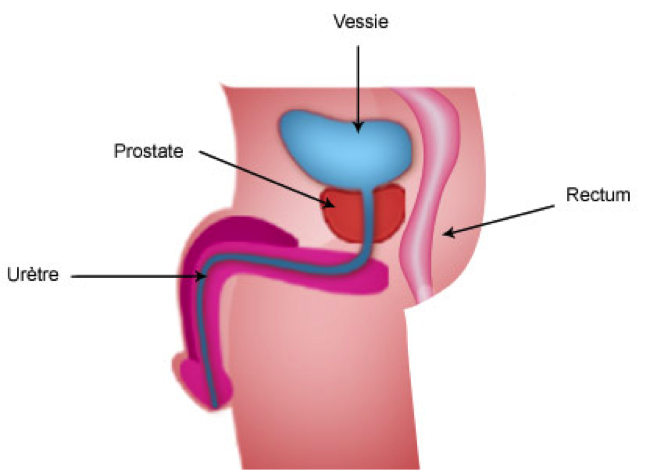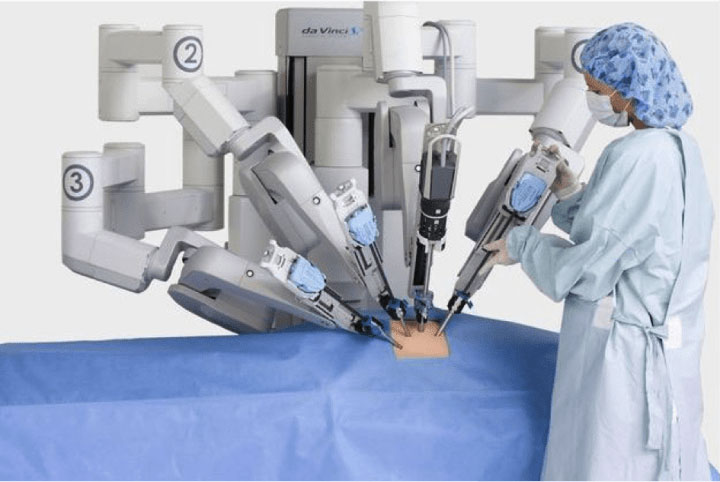Prostate cancer
Radical prostatectomy: what does this operation consist in ?
This surgery technique consists in entirely removing the prostate affected by the cancer cells.
The prostate gland is a male reproductive organ whose main function is to secrete prostate fluid, one of the components of semen.
It is located between the bladder and the urethra. The urethra is a thin tube through which urine flows from the bladder.

About functions that enable to have an erection : nerves which trigger erections lie just next to the prostate. Before the surgery and depending on the wish of the patient and the cancer stage, the surgeon will decide or not to try to preserve these nerves in order to maximize the chances of retaining erectile function.
Depending in the cancer stage and according to the recommendations of scientific societies such as the European Association of Urology, the surgeon will also tell the patient if it is necessary to perform a lymph node dissection or not. The latter consists in removing the lymph nodes from the pelvis area.
The surgery process
The surgeons within the Civilian Hospitals of Colmar can rely on Da Vinci X robotic assistance to perform the surgery operation.
Robotic assistance offers many benefits to surgeons and patients compared to open surgery, including:
- an easier access to the pelvic area,
- some more accurate gestures,
- a limitation of the size of the abdomen incisions,
- a better overview during the surgery.
Installation
A few meters by the operating table, the surgeon operates from the console and controls the robot movements. The latter cannot operate without the surgeon control.
Six incisions are made in the abdomen : 5 incisions the size of a dime through which the robotic arms and camera will be inserted and 1 larger incision (about 5cm) from which the prostate will be extracted.
During the surgery operation the abdominal cavity is filled with gas (CO2) in order to create a sufficient space to insert cameras and robotic arms and give a good overview of the area to operate to the surgeon.

The surgeon had a 3D extended vision of the operated zone (thanks to the stereoscopic camera) that enables him to act very precisely. This accurateness will be very much appreciated in case of an attempt to preserve erectile nerves (refer to the surgery process).
Surgery place
Specific room for robotic assistance surgeries
Specific equipment is available in this room and close to it.
A team of nurses and anesthetists is dedicated to this surgical technique. Specific knowledge and training are indeed required to work in this room.
The operating room nurse team is trained to ensure the sterility of the robot during the whole intervention.
Surgery follow-up
Follow-up in the postoperative monitoring room
The anesthesist doctor decides when he can return to his room, accompanied by a nurse from the urology service.
He can eat again a very short time after.
He will stand up again for the first time together with a nurse and then returns to a normal life.
The urinary catheter will be removed by a nurse on a date decided by the surgeon.
At home
Exit date decided in collaboration with the surgeon
Normal diet once at home
Scars are rather small but it is important to respect a rest period of about 1 month to ensure an optimum healing.
It is recommended to walk on a regular basis.
The surgical fasteners will be removed by a visiting nurse with no pain at all.
In the future
Perineal reeducation and follow-up of the patient
A kinesitherapy prescription is granted by the surgeon for perineal reeeducation.
There is anon-call doctor 365 days a year and 24 hours a day so do not hesitate to get to emergencies in case of trouble.
An appointment will be made 6 weeks after the intervention with the surgeon. A PSA-test will have to be performed a few days before this date in a medical lab.
